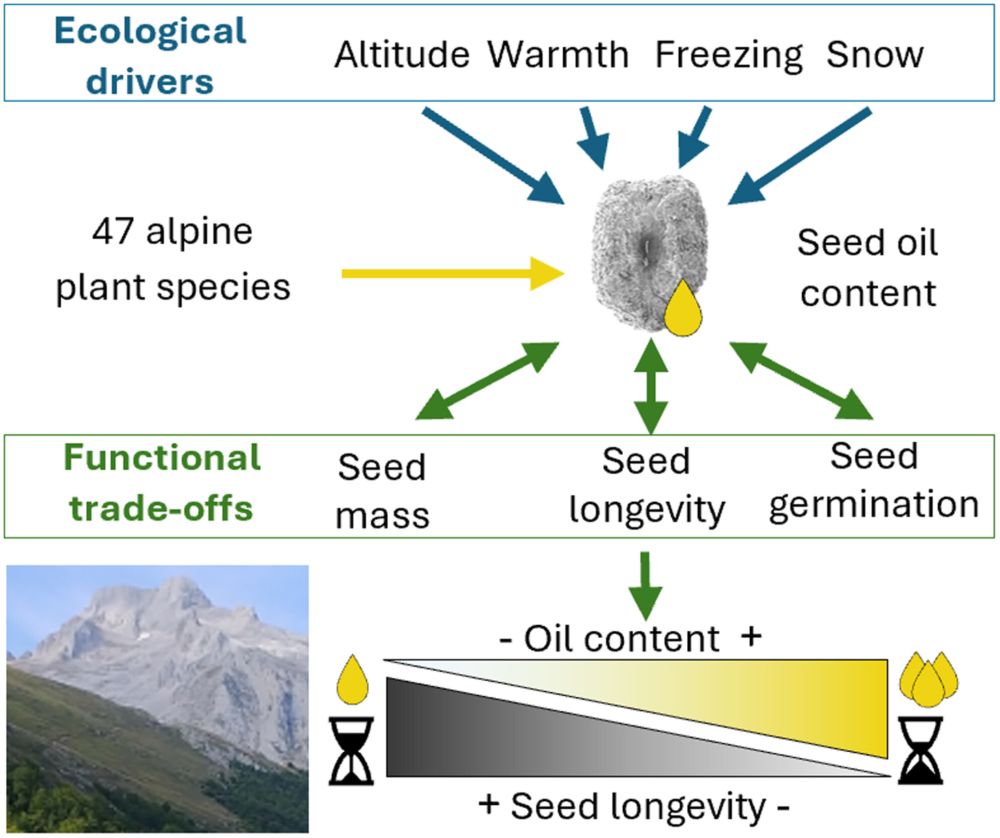Deciduous leaves may have evolved to be symmetrical and subtly lobed so they fall quicker and land near their parent tree, recycling their annually sequestered carbon. Join us 22 Oct 3:00 PM (London, UK) to hear #JRSocInterface author Kaare Jensen talk about his research: cassyni.com/events/5PbU2...
17.10.2025 08:49 — 👍 22 🔁 6 💬 0 📌 2

IAVS Symposium 2026, Thematic 'Understanding Ecosystems Through Vegetation'.
📢 68th #IAVS Symposium: Understanding #Ecosystems through #Vegetation | 22-26 June 2026, Spain
Join us to explore how vegetation shapes #biodiversity and ecosystems worldwide!
📅 Call for Special Session proposals is now open: 15 Oct – 15 Nov 2025
👉 Details: gijon2026.iavs-meetings.org
#IAVS2026
22.10.2025 06:28 — 👍 22 🔁 13 💬 0 📌 2

Compositional novelty for plants, fungi and bacteria. Compositional novelty was calculated as the NMDS multidimensional distance from each urban plot to the centroid of two reference pre-urban habitats (forests, panels A-C-E; and meadows, panels B-D-F). Novelty was calculated separately for plants (panels A-B), fungi (panels C-D) and bacteria (panels E-F).
We used the NMDS to calculate a compositional novelty index, using the distance from each of the urban plots to the centroid of the two reference pre-urban habitats.
Novelty was found higher when compared to forests than to meadows and also found higher for plants than for fungi and bacteria.
10.10.2025 08:52 — 👍 1 🔁 0 💬 1 📌 0


Plant, fungal and bacterial diversity across habitats. Top panels show Venn plots for the shared numbers of (A) plant species, (B) fungal ASVs and (C) bacterial ASVs between pre-urban (forests, meadows) and urban (parks, roadsides, residential lots and industrial lots) habitats. Bottom panels show biplots of community composition ordination produced by Non-metric Multi-Dimensional Scaling (NMDS). The NMDS were conducted for (D) the plant survey (by species presence/absence), (E) the soil fungal survey (by ASV presence/absence) and (F) the soil bacterial survey (by ASV presence/absence). Colors indicate the habitat. In the biplots, arrows and labels indicate soil variables with a significant correlation with the composition of the communities.
We tested the hypothesis that cities are composed of different degrees of ecological novelty by studying four urban (parks, roadsides, and residential and industrial lots) habitats with differing degrees of management and human legacy and two natural ones (hay meadows and forests).
10.10.2025 08:52 — 👍 1 🔁 0 💬 1 📌 0

Today I presented at #iDivconference2025 on using the microclimf R-package to model within-forest climate conditions for vegetation science 🌳🌡️. The model is performing really well so far—exciting insights ahead!
Full results coming soon at #BES2025 this December 🌱
01.10.2025 12:52 — 👍 5 🔁 1 💬 1 📌 0


During the last day of the conference we visited one of the last Abies pinsapo forests, a tree endemic only to Málaga and Cadiz in Southern Spain.
Also we were able to visit the Botanical Garden El Castillejo, where Abies pinsapo and other endangered plants are reproduced for their conservation.
30.09.2025 13:15 — 👍 2 🔁 0 💬 0 📌 0


Last week I could attend the II SEBOT conference in Seville, where I presented my research focused on the natural communities of Scots pine (Pinus sylvestris) in the Iberian Peninsula.
@sebot.bsky.social
30.09.2025 13:15 — 👍 6 🔁 2 💬 1 📌 0


El viernes 26 estaremos en #Gijón en la #EuropeanResearchersNight con el stand "Las plantas viajeras" @universidadoviedo.bsky.social @imibasturias.bsky.social #science4all #MSCANight #NIGHTSpain
17.09.2025 08:37 — 👍 4 🔁 3 💬 1 📌 0

This research represents the most profound study of the family Orchidaceae in Asturias, which can be qualified as an European hotspot for orchids
@sebot.bsky.social
@sebicop.bsky.social
@jovenesbotanica.bsky.social
@uodivulga.bsky.social
@imibasturias.bsky.social
@natusferaes.bsky.social
@gbif.es
13.09.2025 08:56 — 👍 4 🔁 1 💬 0 📌 0

Represention of the most important variables in the understanding of the ecology of the orchid family in the Principality of Asturias.
As expected, most Asturian orchids were found to prefer open and sunny spaces, (i.e., grasslands, shrubalnds), with only a few growing on shady forests.
Yet, soil pH was found as one of the main drivers in their distribution, as their diversity decreases eastwards, where acid soils are dominant.
13.09.2025 08:56 — 👍 1 🔁 0 💬 1 📌 0

Orchis spitezlii

Ophrys lutea

Ophrys speculum
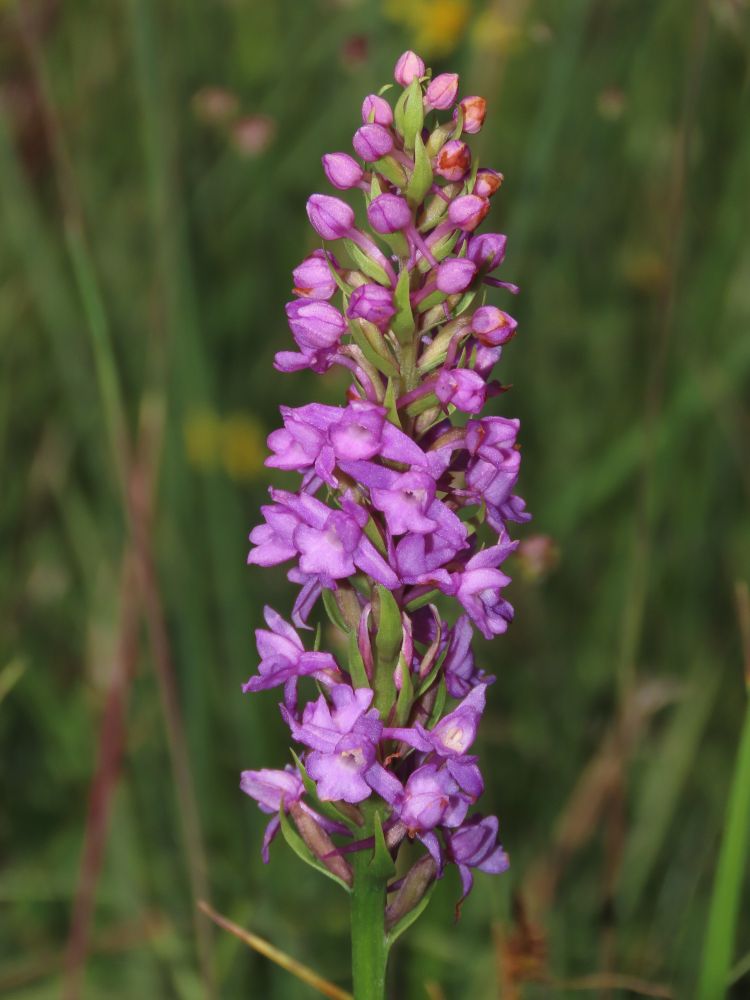
Gymnadenia densiflora
Thus, we have determined that in Asturias we can find, at least, 52 confirmed species, more than all of Portugal, and 13 hybrids.
Some of these taxa were recorded for the first time for the region, such as Ochis spitzelii, Ophrys lutea, O. speculum or Gymnadenia conopsea.
13.09.2025 08:56 — 👍 1 🔁 0 💬 1 📌 0

Orquídeas de Asturias
En este proyecto se recopilarán todas las orquídeas silvestres presentes en el Principado de Asturias. El proyecto está mantenido por el Laboratorio de Vegetación y Biodiversidad de la Universidad de ...
In addition to our own fieldwork, we have collected many records from other sources, such as different herbaria, scientific literature, social media, and of course, citizen science platforms such as @inaturalist.bsky.social where we have created our own project:
www.inaturalist.org/projects/orq...
13.09.2025 08:56 — 👍 2 🔁 0 💬 1 📌 0
Orchids of the Principality of Asturias (Northwestern Spain) | Mediterranean Botany
In this study we present a review of the orchid family in the Principality of Asturias, Northwestern Spain. The study area comprises 10,000 km² for which we have compiled and curated up to 9197 records coming from several sources: fieldwork, herbaria, specialized publications, gray-literature, citizen science platforms, Global Biodiversity Information Facility (GBIF) and social media. The territory comprises 52 confirmed species and 13 hybrids, with other 16 possibly present species being discussed and still other 6 explicitly dismissed. Gymnadenia densiflora (Wahlenb.) A. Dietr. and all nothotaxa, except those in Serapias, represent novelties for the area. For each of the 52 species we provide a brief description of their habitat, altitudinal range and flowering period. Additionally, we present a statistical exploration of the main drivers of orchids’ ecology and distribution in the territory. Our review demonstrates how the Principality of Asturias, despite its marginal geographic position—away from major diversification centers—, and the scarcity of detailed floristic studies and, in particular, of those specifically focused on orchids, qualifies as a significantly orchid-rich region within the European context, even when judged by the demanding standards of the rich Iberian flora. The role of citizen science, particularly triggered by these cherished plants, has been and will continue to be crucial in perfecting our knowledge of Asturian orchids.
🚨Paper alert!🚨
Just published in Mediterranean Botanty at
revistas.ucm.es/index.php/MB...
In this study we focused on the orchid diversity of the Principality of Asturias (NW Spain) and the drivers behind such diversity.
13.09.2025 08:56 — 👍 9 🔁 6 💬 1 📌 0
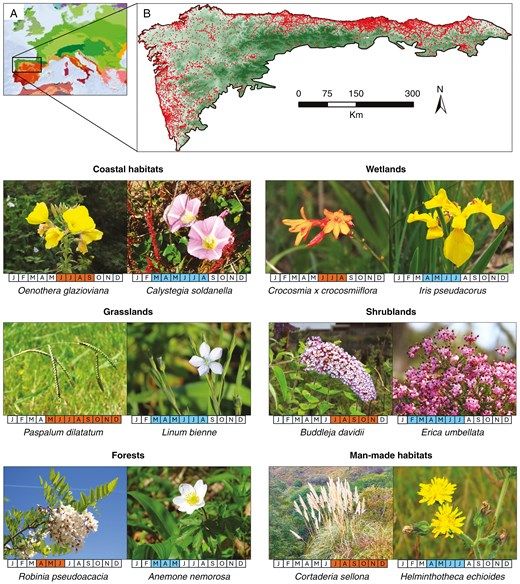
(A) Ecorregiones de Europa occidental, obtenidas del conjunto de datos RESOLVE Ecoregions (Ecoregions2017 ©Resolve; https://ecoregions.appspot.com/). El rectángulo negro incluye la ecorregión del estudio (en verde) y parte de otras ecorregiones. (B) Ecorregión del estudio. Los colores más oscuros representan mayores altitudes (≤2626 m). Los puntos rojos indican presencias registradas de especies invasoras (descargadas de diferentes bases de datos; ver el texto principal). Las imágenes de flores dentro de cada tipo de hábitat representan especies invasoras comunes (izquierda) y nativas (derecha) que ocurren en dichos hábitats. Los colores rojo y azul representan la fenología de la floración de las especies invasoras y nativas, respectivamente.
¿Sabías que las plantas #invasoras florecen más tarde y por más tiempo que las nativas? Un estudio con datos de @gbif.org e @inaturalist.bsky.social - @natusferaes.bsky.social así lo ha observado para el norte de la Península Ibérica:
▶️ doi.org/10.1093/aob/... 👇
26.06.2025 12:54 — 👍 11 🔁 6 💬 1 📌 0
These findings highlight the importance of considering phenology of invasive and native species in prediction, early response and management of biological invasions.
@sebot.bsky.social @imibasturias.bsky.social @jovenesbotanica.bsky.social @invaplant.bsky.social @uodivulga.bsky.social
12.06.2025 20:26 — 👍 1 🔁 0 💬 0 📌 0

Ipomoea indica

Tradescantia fluminensis

Carpobrotus acinaciformis

Arctotheca calendula
This temporal mismatch could allow invasive plants to avoid direct competition during key periods of their life cycle.
Also, a prolonged flowering might confer a competitive advantage to invaders by maximizing the access to resources when most native plants have completed their reproductive cycle.
12.06.2025 20:26 — 👍 1 🔁 0 💬 1 📌 0

We have found that invasive species display a delayed and longer flowering phenology when compared to native species, especially those invaders from temperate and tropical occurring in man-made habitats.
12.06.2025 20:26 — 👍 1 🔁 0 💬 1 📌 0

In this study we have compared the flowering start, ending and duration of invasive against native plants co-occurring at the same elevations in the Cantabrian Mixed Forests Ecoregion, taking into account also the habitat where they grow and their climatic and geographic origin.
12.06.2025 20:26 — 👍 1 🔁 0 💬 1 📌 0

Dryopteris aemula

Sori of Dryopteris aemula, with their characteristic glands

Cystopteris diaphana (= D. viridula)

Spike-ornamented spores of Cystopteris diaphana (= C. viridula)
Some of them need to be checked in the lab to be sure of the species, like Dryopteris aemula, characterized by its glandular sori, or Cystopteris diaphana (= D. viridula), with a quite peculiar ornamentation in its spores.
05.06.2025 19:01 — 👍 2 🔁 0 💬 0 📌 0
@jovenesbotanica.bsky.social @sebot.bsky.social @sebot.bsky.social @gtp-sebot.bsky.social
04.06.2025 21:00 — 👍 1 🔁 0 💬 0 📌 0

Llames waterfall in Villaviciosa (photo: Eduardo Fernández Pascual)

Woodwardia radicans in Villaviciosa (photo: Eduardo Fernández Pascual)

Woodwardia radicans community in Villaviciosa (photo: Eduardo Fernández Pascual)

Vandenboschia speciosa
Some of these ferns can become dominant and create their own communities, like the huge Woodwardia radicans or Culcita macrocarpa.
However, other species are rarer and must be sought in very specific refugia, like Vandenboschia speciosa of Hymenophyllum tunbrigense, which grow in very humid walls.
04.06.2025 21:00 — 👍 7 🔁 0 💬 2 📌 0
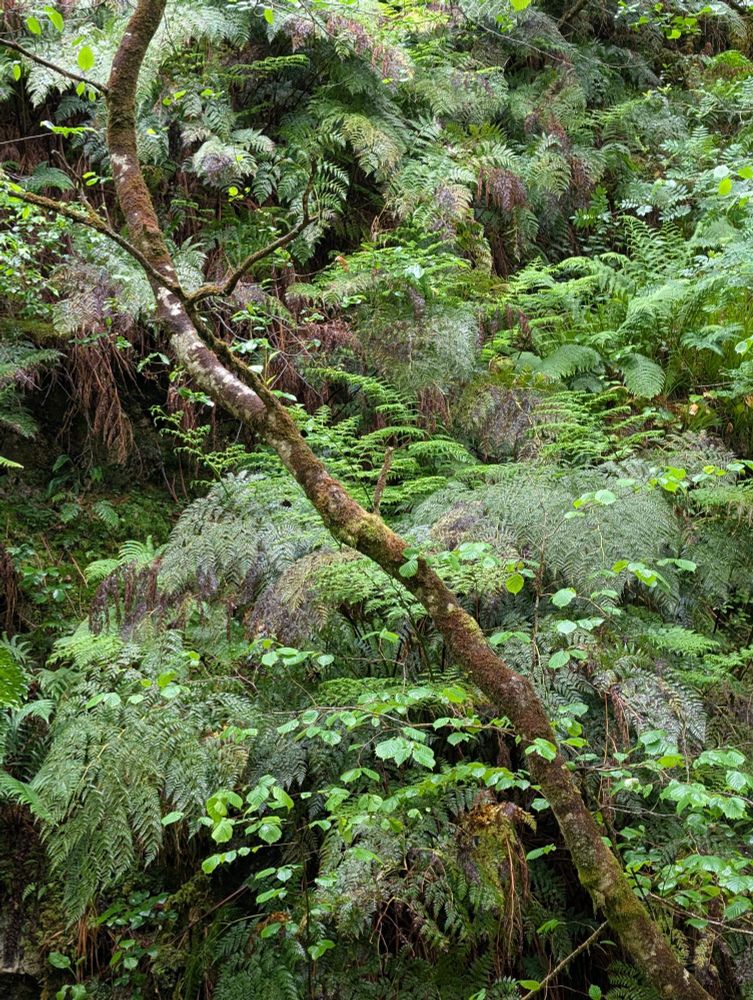
Culcita macrocarpa community in Nueva (Llanes, Asturias) (photo: Eduardo Fernández Pascual)

Culcita macrocarpa community in Nueva (Llanes, Asturias) (photo: Eduardo Fernández Pascual)

Culcita macrocarpa

Hymenophyllum tunbrigense
Yesterday we visited some places in Asturias where unusual ferns can be seen.
These ferns are more typical from tropical and subtropical regions, like Macaronesia.
Yet, they have survived to several climatic shifts and thrive in humid and warm valleys close to the coast, like Nueva, in Llanes.
04.06.2025 21:00 — 👍 32 🔁 4 💬 1 📌 0

Invasive plants have a delayed and longer flowering phenology than native plants in an ecoregional flora
🎉 Good news! The paper ‘🎉 Good news! The paper ‘Invasive plants have a delayed and longer flowering phenology than native plants in an ecoregional flora’ in @annbot.bsky.social by Adrián Lázaro-Lobo and co-authors is now #free for a limited time 🧵(1/7)
👉 doi.org/ppkm
#AoBpapers #PlantScience
29.05.2025 10:08 — 👍 8 🔁 4 💬 1 📌 0

Hoy ha comenzado el #VBiomaratón de Flora Española. ¡A esta hora ya tenemos más de 2000 observaciones en nuestro proyecto de @inaturalist.bsky.social! Puedes seguir las observaciones en tiempo real en www.inaturalist.org/projects/v-b...
@sebot.bsky.social @sebicop.bsky.social
15.05.2025 14:22 — 👍 12 🔁 9 💬 0 📌 0
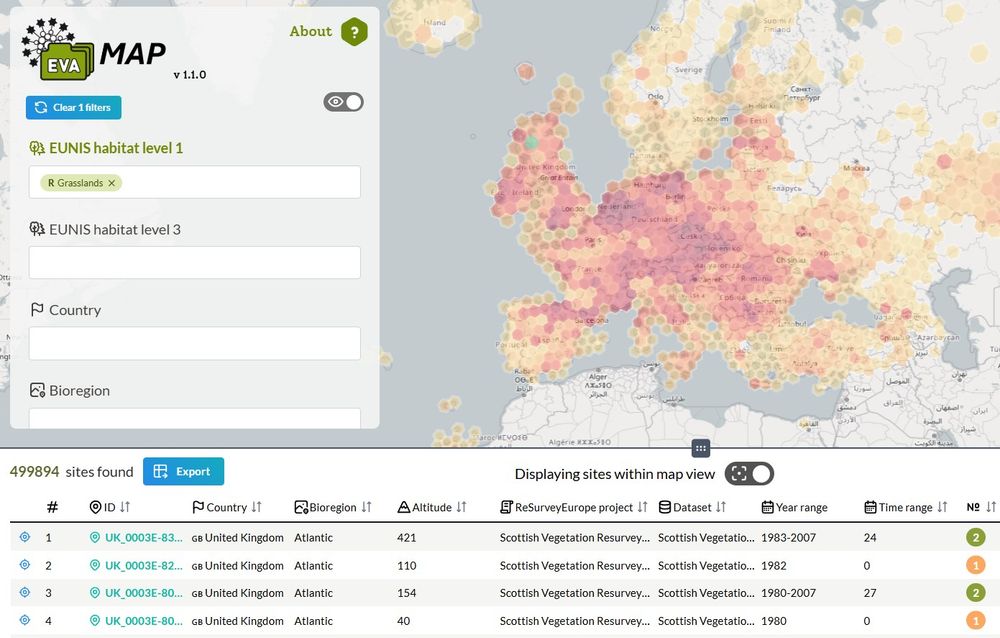
EVA-MAP: www.EVAMAP.eu
We have launched a new online map of vegetation plots in the European Vegetation Archive (EVA) and ReSurveyEurope database. You can select plots using a filtering form or drawing an area in the map, explore plot metadata and export lists of selected plots with metadata.
07.05.2025 05:43 — 👍 30 🔁 7 💬 1 📌 0


In this study we tested if the floristic dissimilarities of eight different forests from the temperate Europe are caused by environmental filters (e.g., climate) or the dispersal limitation of their plants (i.e., their current or past isolation).
Stay tuned for further updates!
04.05.2025 18:54 — 👍 1 🔁 0 💬 0 📌 0
Bibliotecas de Biología, Ciencias de la Salud, Ciencias Jurídico-Sociales y Química
Cuenta en X: https://x.com/bcsuniovi
Postdoc in @econovoau.bsky.social - diversity dynamics in novel ecosystems. Palaeo/macro-ecology.
Also chatting craft beer, tabletop gaming, and open/ethical science.
Views mine. He/him. 🐚🐟🌍
Applying and developing DNA-based molecular tools for the study of ecosystems and biodiversity.
Working at #TaxusMedioAmbiente. Spain.
Metabarcoding | eDNA | Phylogenetics | Pop Gen
Biólogo, zoólogo.
A veces hago fotos.
Biologist living in Mallorca 🪶✈️
miguel.mcminn@gmail.com
PhD student in Mycology (University of Vigo - RBG Kew).
Mycology, Botany and Sustainability. Wannabe-bagpiper.
💚🍄🌿🏳️🌈🎵Gz💚
Ecologist 🇦🇷🇺🇸 Associate Professor University of Colorado, Boulder
Community Ecology, Landscape Ecology, Insects, Biodiversity Conservation
🐜🐝🦗🌻 🦎🐞🌲|
Ph.D. candidate at University of Freiburg
Blending tropical ecology, molecular biology, and tree climbing to uncover and protect the secrets of rainforest biodiversity.
- Mainly on Youtube (MarioLanzas.)
- Prints and +: Redbubble/people/mariolanzas
🍉
North Wales based fern & lycophyte botherer (VC51); biological recorder working on Quillworts and Honduran Fern Flora. Love botany, libraries, maps, books, education and nature. Oh, and did I mention #FernFriday?
FLS, BPS secretary & Cofnod LRC chair.
30| PhD in fire ecology.
Trato de explicar cositas sobre cambio climático, incendios forestales, sequías y ecología 📈🌍
I research at the CEAM Foundation on plant recovery under fire-drought interaction integrating functional traits 🌱🔥
Zoólogo y divulgador del mundo natural 🌳🪲🐦⬛🐝 Ilustrador de la naturaleza ✍️ Jardín Botánico de Castilla-La Mancha 🆎 My country? 👉🏻 🇪🇺
Ecobiologiste. La 🌏 est riche de ressources pour tous pero sus almacenamientos son finitos , jadi kita harus membaginya 🫱🏿🫲🏼 democratically
Biologist 🌱 | Interested in research and conservation of plant resources
Bluesky account of the Iberian Group of Urban Ecology (IGUE) of the Spanish Association of Terrestrial Ecology (AEET).
https://igue-aeet.github.io/
Biodiversity, biological invasions, plant ecology & plant-herbivore interactions.
https://www.researchgate.net/profile/Jonatan-Rodriguez
PhD Student, EBD-CSIC | Community ecology, coexistence, time series
Comunicación y divulgación científica en la Universidad de Oviedo
Ph.D. in alpine ecology, fire-ecologist, jingle-jangle guitarist and noise-ambient maker, left-back player, part-time dinosaur enthusiast and full-time fan of Irish literature 🇵🇸























